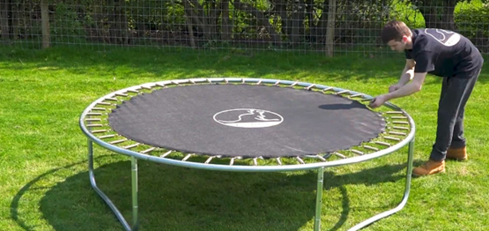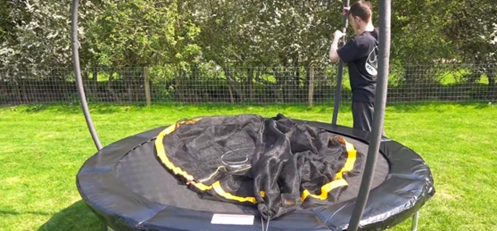How to Put a Trampoline Together: Complete Assembly Instructions
Assembling a trampoline may seem intimidating at first, especially if you’ve never done it before. However, with the right instructions and tools, the process can be quite manageable. Whether you're setting it up for the first time or refreshing your skills, following a detailed guide on how to put a trampoline together can ensure the trampoline is safe, secure, and ready for use. This comprehensive guide will take you through the step-by-step process of putting a trampoline together, from preparing your tools to completing the setup. Let’s break down the assembly process to help you enjoy a fun and safe jumping experience.

Preparing for Assembly: Tools and Materials Needed
Before diving into the assembly process, it’s important to gather all necessary tools and materials. A well-organized workspace and having everything you need on hand will make the process much smoother and more efficient. You’ll need your trampoline’s manual for reference, which provides detailed instructions specific to your model. Tools such as a wrench, screwdriver, mallet, spring puller, and gloves are essential to safely handle the parts. Also, ensure you have all the parts, including the frame pieces, legs, mat, springs, safety pads, and an enclosure net if your trampoline has one. Gathering everything before starting will help you avoid delays and ensure a quicker setup.
How to Put a Trampoline Together: Step-by-Step Instructions
Assembling the Frame and Legs
The first step in assembling your trampoline is putting together the frame and legs. Start by carefully laying out the frame pieces in their respective positions. Follow the manufacturer’s instructions for connecting the pieces, whether it’s circular or rectangular. This will create the skeleton of the trampoline. Once the frame is connected, insert the legs into the appropriate frame sockets and secure them tightly. It’s important to double-check each connection to ensure they’re securely fastened. A stable and well-connected base is essential for the entire trampoline’s structure, as it supports the mat and springs during use.
Attaching the Springs and Mat
After the frame is assembled, the next step is to attach the jumping mat to the frame using springs. Begin by positioning the mat at the center of the frame and use a spring puller to attach the springs one by one. Start with four evenly spaced points on opposite sides of the trampoline, which helps to distribute the tension evenly. Continue by working in a criss-cross pattern, attaching the springs to all the frame sockets. This even distribution of tension prevents uneven stress on the mat and helps maintain a consistent bounce. Make sure each spring is securely attached and that the mat is centered on the frame before moving to the next step.
Securing the Safety Pads and Other Accessories
Once the mat and springs are securely attached, the next step is to add the safety pads. These pads cover the springs and frame to protect jumpers from injury. Align the pads with the trampoline frame, ensuring that the foam padding fully covers the springs and the sharp edges of the frame. Depending on your model, you may need to tie or fasten the safety pads to the frame. Once in place, check that the pads are tightly secured to prevent them from slipping during use. If your trampoline includes additional features like an enclosure net, this is the time to attach it. Follow the manufacturer’s guidelines for any extra components to ensure a safe setup.
Common Mistakes to Avoid During Trampoline Assembly
Assembling a trampoline can be straightforward, but there are a few common mistakes to watch out for. One of the most important things is to always follow the manual. Skipping steps or ignoring the manufacturer’s instructions can lead to improper setup, resulting in instability or safety issues. Additionally, avoid rushing the assembly process. Each step is important and should be completed thoroughly before moving on to the next. Another mistake is using incorrect tools. Always use the tools recommended in the manual, as using the wrong tools can cause damage to the parts or result in injury. Lastly, ensure all parts are secured properly, especially the safety pads, to prevent accidents.
How to Test and Ensure Proper Trampoline Setup
Checking Stability and Tension
Once the trampoline is assembled, it’s important to check its stability and ensure the mat has the right amount of tension. Start by pressing down on different areas of the frame to check for any wobbling. The frame should feel firm and secure, with no noticeable movement. Next, check the mat’s tension. Press your hand or foot into the center of the mat. It should bounce back smoothly and evenly. If the mat feels loose or overly tight, you may need to adjust the springs for proper tension. Proper stability and tension are essential for safe use, providing a smooth bounce and preventing injuries.

Testing the Jumping Mat
Climb onto the trampoline and gently perform a few small jumps to test how the mat responds. Pay close attention to the bounce across the entire surface. A well-set trampoline will have a consistent bounce across the entire mat. If you notice any areas that feel significantly harder or softer, it could indicate that the springs are unevenly placed, or that some are not tightly secured. A uniform bounce is critical for both enjoyment and safety. If you find uneven bounce spots, it’s a good idea to revisit the spring placement and adjust the tension to ensure the mat is properly aligned and the trampoline is working optimally.
Verifying Safety Features Are Properly Installed
Safety features, such as the pads and enclosure net, are just as important as the trampoline’s structural setup. Inspect the safety pads to ensure they are securely fastened and cover all the springs and frame edges. Pads should be tightly aligned with no gaps where a jumper could accidentally come into contact with the frame. If your trampoline includes an enclosure net, check that it is properly attached to all the posts and that the net is taut. Make sure that all entrance points have secure zippers or Velcro closures to prevent accidental falls. A trampoline with well-secured safety features will provide a safer jumping experience.
Conclusion
Assembling a trampoline properly is essential for its longevity, safety, and performance. By following the step-by-step instructions outlined in this guide on how to put a trampoline together and avoiding common mistakes, you can set up your trampoline with ease and confidence. Always perform thorough checks after assembly to ensure stability, proper tension, and safety. With the right assembly, your trampoline will provide years of fun and exercise. Regular maintenance and safety checks are also crucial to maintaining a safe jumping environment. Enjoy your trampoline experience, knowing that it has been set up securely and will offer you countless hours of fun.
FAQ
How long does it take to put a trampoline together?
The time it takes to assemble a trampoline can vary based on size and complexity. On average, it takes about 2-4 hours. Having all tools and parts ready and following the manual closely can expedite the process.
Can I assemble a trampoline by myself?
Assembling a trampoline is easier with two people. While it’s possible to do it alone, having help can make handling large parts, aligning pieces, and tensioning the springs more manageable.
How do I maintain my trampoline after assembly?
Regular maintenance includes checking for wear and tear, ensuring all parts are secure, and keeping the trampoline clean. Weatherproof covers can help protect it from the elements. Inspecting the trampoline before use is also good practice to ensure safety features are intact.








